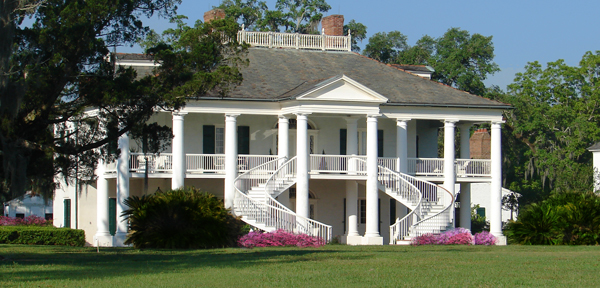
Evergreen Plantation director Jane Boddie said movie location scouts often visit the isolated plantation on the West Bank of St. John the Baptist Parish in Edgard.
In recent years major motion pictures such as ‘The Skeleton Key’ and ‘Abraham Lincoln: Vampire Hunter’ have been filmed at the plantation.
So it was nothing new when Boddie was told by a location scout that a director would be stopping by to check out the area.
‘They say, ‘We have a director who is coming into town,’ and they don’t tell you who it is,’ Boddie said.
On the day of the visit, Boddie said she knew who it was before she even saw him.
‘I could hear him talking before I could see him and I could recognize his voice. He has a very distinctive voice,’ Boddie said.
Academy Award-winning director Quentin Tarantino had paid the plantation a visit.
‘It was a very big surprise,’ Boddie said. ‘The first person we saw was Quentin Tarantino.’
After the visit, Tarantino selected the plantation as the main site for his latest movie, ‘Django Unchained,’ which was released to positive reviews on Christmas Day and is already considered a favorite for a number of Academy Awards.
The film stars Jamie Foxx as Django who is a former slave turned bounty hunter mentored by a character played by German-Austrian actor Christopher Waltz. The two embark on a journey together to rescue Django’s wife from a brutal plantation owner played by Leonardo DiCaprio.
Boddie said after the initial visit things moved quickly and shooting soon began. The shooting went on for 14 months.
‘They arrive at your doorstep with 90 some odd trucks, seriously. So that basically is a huge number of vehicles. A large number of the biggest cranes you have ever seen in your life,’ Boddie said.
Her main goal was to keep the historic site she had worked so hard to maintain from damage.
Boddie was the force behind restoration efforts at the plantation that began in 1997 on behalf of owner Matilda Stream and her family.
‘Restoration of the property and the cultural history is our major objective,’ Boddie said. ‘Each set of buildings has its own needs.’
She said she patrolled the plantation property at all hours to ensure that the property’s 37 National Historic Registry buildings remained unharmed during the shooting.
‘You are simply never out of sight. I have a golf cart I’d drive around the property. You have to understand that these people come in at 5:30 a.m. and might not leave until midnight,’ Boddie said. ‘It just totally takes your life. You get very, very little sleep. You just have to decide it is worth doing and you do it. It is not an easy thing to do and it requires a strong contract.’
Boddie said throughout the experience she was very impressed with the film’s cast and crew.
‘They were here a very long time so you actually get to know them and meet their families,’ Boddie said. ‘I’ve never known anyone anywhere to work as hard as these people work. It is an astounding experience to watch them work. They do not play at all.’
Despite the long hours and number of months the project went on, Boddie said she was pleased with the final result and would not hesitate to do it again.
‘I’d go back and do it if they came back tomorrow. It was a very good experience,’ she said. ‘I was impressed with the people. We had no damage or anything.’
Local residents may not have even known that a large portion of the movie was shot on the plantation.
‘We continued to be open to the public and in all of those months we were only closed for 20 days,’ she said. ‘Most of the time people didn’t even know they were here.’
However, local residents started to get suspicious when the filmmakers changed out the plantation’s historic sugarcane crop, which they still harvest ever year.
‘One of the things was they put a cotton plantation in this movie and we are a sugar cane plantation. So they had to change from a sugar cane plantation to a cotton plantation,’ Boddie said. ‘That was a transformation.’
In addition, the filmmakers constructed a home in the back of the property that was used for a pivotal part of the film.
‘They built a very large house at the back of Evergreen equally the size of the plantation and blew it up,’ Boddie said. ‘It was amazing.’
Boddie said the funding the plantation received from the film will go towards further restoration efforts on the property.
‘We certainly make as much of the funding as we can,’ she said.
Since the film’s release, the plantation has already started to see an increase in the number of visitors who pay to take a tour of the property.
‘People had actually seen the movie on Christmas Day and came the next day,’ Boddie said.
She said she expects a lot more people to visit as the film becomes more widespread.
‘We’re anticipating it. The house is very visible in the movie and they can have a picture in front of the house. That is fine, they can do it,’ Boddie said.
Those connected to the film, including Boddie, were treated to a sneak preview at the Prytania Theater in New Orleans in December.
When asked if she was a fan of Tarantino’s films before she met him, she paused for a moment before answering.
‘I am now!’ she said.




Be the first to comment